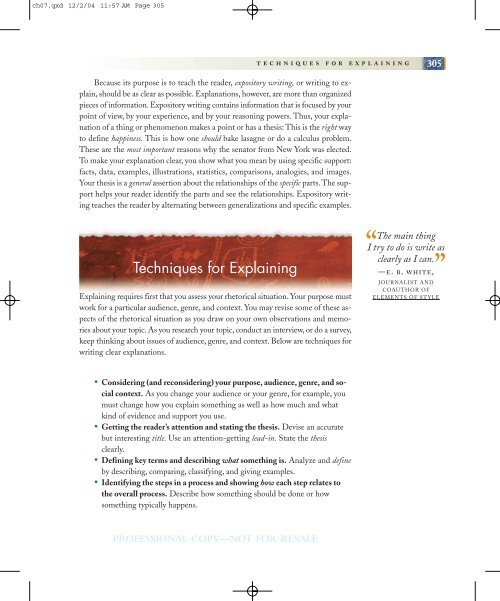A prolific painter of portraits before and after the French Revolution ...
A prolific painter of portraits before and after the French Revolution ...
A prolific painter of portraits before and after the French Revolution ...
You also want an ePaper? Increase the reach of your titles
YUMPU automatically turns print PDFs into web optimized ePapers that Google loves.
ch07.qxd 12/2/04 11:57 AM Page 305<br />
techniques for explaining<br />
305<br />
Because its purpose is to teach <strong>the</strong> reader, expository writing, or writing to explain,<br />
should be as clear as possible. Explanations, however, are more than organized<br />
pieces <strong>of</strong> information. Expository writing contains information that is focused by your<br />
point <strong>of</strong> view, by your experience, <strong>and</strong> by your reasoning powers. Thus, your explanation<br />
<strong>of</strong> a thing or phenomenon makes a point or has a <strong>the</strong>sis: This is <strong>the</strong> right way<br />
to define happiness. This is how one should bake lasagne or do a calculus problem.<br />
These are <strong>the</strong> most important reasons why <strong>the</strong> senator from New York was elected.<br />
To make your explanation clear, you show what you mean by using specific support:<br />
facts, data, examples, illustrations, statistics, comparisons, analogies, <strong>and</strong> images.<br />
Your <strong>the</strong>sis is a general assertion about <strong>the</strong> relationships <strong>of</strong> <strong>the</strong> specific parts. The support<br />
helps your reader identify <strong>the</strong> parts <strong>and</strong> see <strong>the</strong> relationships. Expository writing<br />
teaches <strong>the</strong> reader by alternating between generalizations <strong>and</strong> specific examples.<br />
Techniques for Explaining<br />
Explaining requires first that you assess your rhetorical situation. Your purpose must<br />
work for a particular audience, genre, <strong>and</strong> context. You may revise some <strong>of</strong> <strong>the</strong>se aspects<br />
<strong>of</strong> <strong>the</strong> rhetorical situation as you draw on your own observations <strong>and</strong> memories<br />
about your topic. As you research your topic, conduct an interview, or do a survey,<br />
keep thinking about issues <strong>of</strong> audience, genre, <strong>and</strong> context. Below are techniques for<br />
writing clear explanations.<br />
‘‘<br />
The main thing<br />
I try to do is write as<br />
clearly as I can.<br />
’’<br />
— E . B . WHITE,<br />
JOURNALIST AND<br />
COAUTHOR OF<br />
ELEMENTS OF STYLE<br />
• Considering (<strong>and</strong> reconsidering) your purpose, audience, genre, <strong>and</strong> social<br />
context. As you change your audience or your genre, for example, you<br />
must change how you explain something as well as how much <strong>and</strong> what<br />
kind <strong>of</strong> evidence <strong>and</strong> support you use.<br />
• Getting <strong>the</strong> reader’s attention <strong>and</strong> stating <strong>the</strong> <strong>the</strong>sis. Devise an accurate<br />
but interesting title. Use an attention-getting lead-in. State <strong>the</strong> <strong>the</strong>sis<br />
clearly.<br />
• Defining key terms <strong>and</strong> describing what something is. Analyze <strong>and</strong> define<br />
by describing, comparing, classifying, <strong>and</strong> giving examples.<br />
• Identifying <strong>the</strong> steps in a process <strong>and</strong> showing how each step relates to<br />
<strong>the</strong> overall process. Describe how something should be done or how<br />
something typically happens.<br />
PROFESSIONAL COPY—NOT FOR RESALE

















